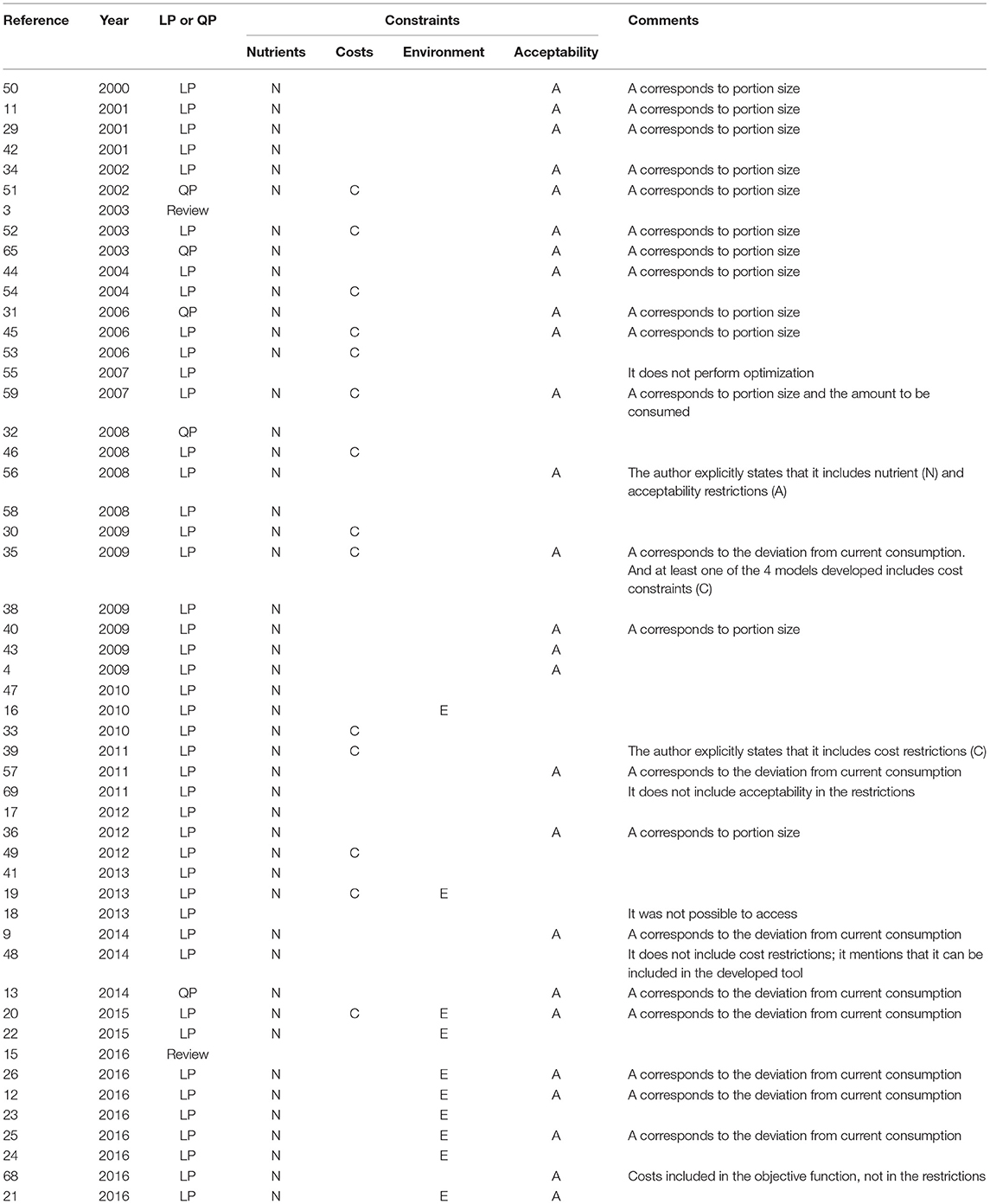
95% of researchers rate our articles as excellent or good
Learn more about the work of our research integrity team to safeguard the quality of each article we publish.
Find out more
CORRECTION article
Front. Nutr. , 13 May 2022
Sec. Nutrition and Sustainable Diets
Volume 9 - 2022 | https://doi.org/10.3389/fnut.2022.850033
This article is part of the Research Topic The Rising Trend of Flexitarianism View all 6 articles
This article is a correction to:
A Review of the Use of Linear Programming to Optimize Diets, Nutritiously, Economically and Environmentally
A corrigendum on
A Review of the Use of Linear Programming to Optimize Diets, Nutritiously, Economically and Environmentally
by van Dooren, C. (2018). Front. Nutr. 5:48. doi: 10.3389/fnut.2018.00048
In the original article, there was a mistake in Table A1 as published. Reference [41] was duplicated twice in the table. Additionally, there were errors in the classification of the articles presented in Table A1. In the Acceptability column the original paper did not consider “portion size” as a constraint to diet optimization. In the revised Table A1 this has been added in the column Comments. The corrected Table A1 appears below. Full reference details for the references cited in the table can be found in the original article.

TABLE A1. Short overview of the reviewed papers, year published, type of programming (linear or quadratic) and constraints used.
In the original article there was also an error in reference [47]. The reference for [47] was incorrectly written as “Maillot M, Darmon N, Drewnowski A. Are he lowest-cost healthful food plans culturally and socially acceptable? Public Health Nutr. (2010) 13:1178–85. doi: 10.1017/S1368980009993028”. It should be “Maillot M, Darmon N, Drewnowski A. Are the lowest-cost healthful food plans culturally and socially acceptable? Public Health Nutr. (2010) 13:1178–85. doi: 10.1017/S1368980009993028”.
In the original article, there also was an error in the section Results, Twelve Studies With Ecological Constraints, Paragraph 1. In the list “France, UK, and New Zealand”, France should not have been included and the reference [60] should not have been included. The updated paragraph appears below.
Several studies—for instance in UK, and New Zealand—have successfully applied LP to optimize diets (4, 19, 33, 38, 39, 44, 46, 47, 57). This section gives an overview of the 12 studies which have applied ecological constraints to 14 diets between 2000 and 2016 (13, 16–26). The studies are summarized in Table 1.
The authors apologize for these errors and state that this does not change the scientific conclusions of the article in any way. The original article has been updated.
AE, JG-L, and ÓV contributed to the conception and the design of this corrigendum and performed the analytic review. JG-L organized the database and first references' analysis of this corrigendum and wrote the first corrigendum draft of the manuscript. ÓV, AE, and CD wrote sections of the manuscript. All authors contributed to manuscript revision, read, and approved the submitted version.
All claims expressed in this article are solely those of the authors and do not necessarily represent those of their affiliated organizations, or those of the publisher, the editors and the reviewers. Any product that may be evaluated in this article, or claim that may be made by its manufacturer, is not guaranteed or endorsed by the publisher.
Keywords: sustainable diet, linear programming, diet costs, nutritional quality, environmental constraints (EC)
Citation: García-Leal J, Espinoza Pérez AT, van Dooren C and Vásquez ÓC (2022) Corrigendum: A Review of the Use of Linear Programming to Optimize Diets, Nutritiously, Economically and Environmentally. Front. Nutr. 9:850033. doi: 10.3389/fnut.2022.850033
Received: 07 January 2022; Accepted: 24 January 2022;
Published: 13 May 2022.
Edited by:
Uma Tiwari, Technological University Dublin, IrelandReviewed by:
William A. Masters, Tufts University, United StatesCopyright © 2022 García-Leal, Espinoza Pérez, van Dooren and Vásquez. This is an open-access article distributed under the terms of the Creative Commons Attribution License (CC BY). The use, distribution or reproduction in other forums is permitted, provided the original author(s) and the copyright owner(s) are credited and that the original publication in this journal is cited, in accordance with accepted academic practice. No use, distribution or reproduction is permitted which does not comply with these terms.
*Correspondence: Óscar C. Vásquez, b3NjYXIudmFzcXVlekB1c2FjaC5jbA==
Disclaimer: All claims expressed in this article are solely those of the authors and do not necessarily represent those of their affiliated organizations, or those of the publisher, the editors and the reviewers. Any product that may be evaluated in this article or claim that may be made by its manufacturer is not guaranteed or endorsed by the publisher.
Research integrity at Frontiers

Learn more about the work of our research integrity team to safeguard the quality of each article we publish.